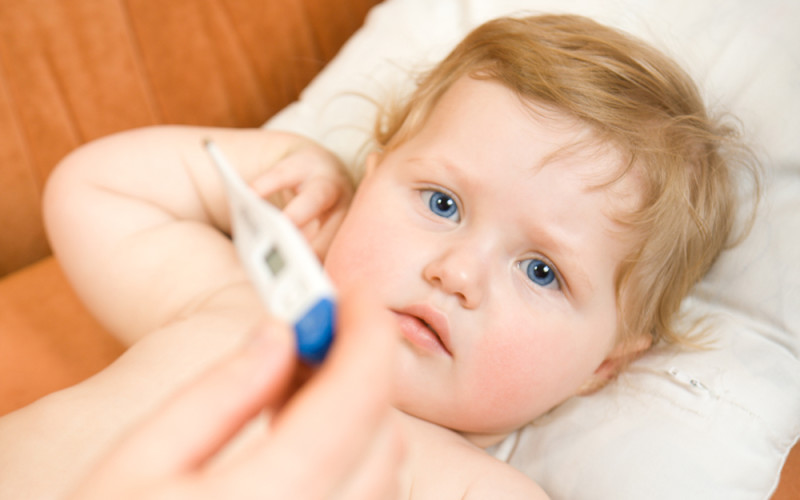What is a fever? And what should you do when your child has one?

Fever is one of the most common reasons children go to the doctor. If you worry when your child has a fever, you are not alone. Fever is something that most parents worry about.
Although it’s natural to be concerned when your child has a fever, it is not a cause for panic. By learning about fever, you can better understand what it means to have a fever, and what to do if your child has one.
In general, a fever for most children is considered to be an internal body temperature of 100.4 degrees Fahrenheit (or 38 degrees Celsius) or higher.
A special portion of the brain controls our body temperature. This portion of the brain is like an internal thermostat, similar to the thermostat in your house. A fever happens when the brain’s “thermostat” resets itself to a higher temperature. When the brain’s thermostat is reset, the body responds by increasing its temperature.
Keep in mind the following when you deal with fever in your child:
Fever is a normal, natural response of the body. It is actually one of the body’s important defense mechanisms to fight infection. A fever is not actually a disease, but rather a symptom of another illness, such as an infection.
A fever by itself (even a high fever) is not dangerous for healthy children. This is a common misunderstanding among families. It is even misunderstood by many doctors, since this was a common belief in the past. Some people worry that a fever can cause brain damage or other serious problems, but we now know this is not true.
It’s important to understand why your child has a fever. Fevers most commonly occur with infection, though other illnesses can sometimes cause fever as well. An infection may just be a simple virus, such as a cold. But a fever could also be caused by a more serious infection that needs prompt medical attention. Even though the fever itself may not be dangerous, on occasion, a very serious infection may be causing the fever.
When you are concerned about the fever, call your child’s doctor. Calling your doctor is especially important if your child is acting very sick, if your child is a young infant, if you are not sure what is causing the fever or if the fever persists for more than two days.
Although a fever is not dangerous, you may want to reduce the fever to help your child feel better.
Giving medication for fever is often appropriate, though it’s very important that the medication be used in a safe manner. Giving medications incorrectly can make your child quite sick. If your child has a fever and seems uncomfortable, follow these American Academy of Pediatrics (AAP) tips to reduce the fever:
- Fever-reducing medications can be given if your child seems uncomfortable. For example, a fever may make your child have altered sleep or behavior, or decreased eating. Medications should not just be given to reduce the fever (also called getting the fever to “break”).
- The goal of the medication should be to make your child more comfortable. So even if the fever doesn’t go away (or “break”), if your child is acting better, the medication has achieved its goal.
- If your child is sleeping comfortably and looks well, you should not wake him to take his temperature or give medication. Waking him would disturb the important rest he needs to help him fight his illness.
- Acetaminophen and ibuprofen are both considered by the AAP to be safe and effective to reduce fever. Neither one is recommended over the other. Ibuprofen is not recommended for children under six months.
- Routine use of alternating between acetaminophen and ibuprofen is not recommended by the AAP. If your doctor does recommend this practice, be extra careful about the dose and timing of the medicines and remember to focus on your child’s comfort, rather than his actual temperature.
- If your child is under 3 months, talk to your doctor before giving any medication for fever. Fever in a young infant can be quite serious. And a fever in a baby less than four to six weeks is an emergency and requires immediate medical attention.
- It is quite common for parents to use the incorrect dose of fever-reducing medications. Make sure to always review the directions on the medication, and talk with your doctor or pharmacist if you have questions about what medicine to use or how to use it.
- There are also ways to help your child’s comfort without medicine. Encourage him to eat and drink to stay hydrated, since fever causes more water to be lost from the body (also called dehydration). Sponging your child in a slightly warm bath can also be helpful. It is important not to use cold water or alcohol, which can both be dangerous.
Fever is an important symptom for parents to understand. Knowing why your child has a fever can be complicated, and knowing how and when to treat a fever can be confusing. Remember to focus on how your child feels and acts, rather than focusing on the temperature. And trust your instincts. No one knows your child as well as you, so if he seems very ill or is not acting right, seek medical attention.
Author Laura Lawler, M.D., FAAP, is chief of Pediatric Hospitalists at Christiana Care.